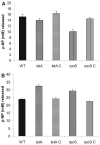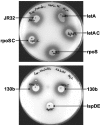The global regulatory proteins LetA and RpoS control phospholipase A, lysophospholipase A, acyltransferase, and other hydrolytic activities of Legionella pneumophila JR32
- PMID: 16452402
- PMCID: PMC1367211
- DOI: 10.1128/JB.188.4.1218-1226.2006
The global regulatory proteins LetA and RpoS control phospholipase A, lysophospholipase A, acyltransferase, and other hydrolytic activities of Legionella pneumophila JR32
Abstract
Legionella pneumophila possesses a variety of secreted and cell-associated hydrolytic activities that could be involved in pathogenesis. The activities include phospholipase A, lysophospholipase A, glycerophospholipid:cholesterol acyltransferase, lipase, protease, phosphatase, RNase, and p-nitrophenylphosphorylcholine (p-NPPC) hydrolase. Up to now, there have been no data available on the regulation of the enzymes in L. pneumophila and no data at all concerning the regulation of bacterial phospholipases A. Therefore, we used L. pneumophila mutants in the genes coding for the global regulatory proteins RpoS and LetA to investigate the dependency of hydrolytic activities on a global regulatory network proposed to control important virulence traits in L. pneumophila. Our results show that both L. pneumophila rpoS and letA mutants exhibit on the one hand a dramatic reduction of secreted phospholipase A and glycerophospholipid:cholesterol acyltransferase activities, while on the other hand secreted lysophospholipase A and lipase activities were significantly increased during late logarithmic growth phase. The cell-associated phospholipase A, lysophospholipase A, and p-NPPC hydrolase activities, as well as the secreted protease, phosphatase, and p-NPPC hydrolase activities were significantly decreased in both of the mutant strains. Only cell-associated phosphatase activity was slightly increased. In contrast, RNase activity was not affected. The expression of plaC, coding for a secreted acyltransferase, phospholipase A, and lysophospholipase A, was found to be regulated by LetA and RpoS. In conclusion, our results show that RpoS and LetA affect phospholipase A, lysophospholipase A, acyltransferase, and other hydrolytic activities of L. pneumophila in a similar way, thereby corroborating the existence of the LetA/RpoS regulation cascade.
Figures






Similar articles
-
Characterization of the major secreted zinc metalloprotease- dependent glycerophospholipid:cholesterol acyltransferase, PlaC, of Legionella pneumophila.Infect Immun. 2005 May;73(5):2899-909. doi: 10.1128/IAI.73.5.2899-2909.2005. Infect Immun. 2005. PMID: 15845496 Free PMC article.
-
The manifold phospholipases A of Legionella pneumophila - identification, export, regulation, and their link to bacterial virulence.Int J Med Microbiol. 2008 Apr;298(3-4):169-81. doi: 10.1016/j.ijmm.2007.11.004. Epub 2008 Jan 4. Int J Med Microbiol. 2008. PMID: 18178130 Review.
-
The Legionella pneumophila response regulator LqsR promotes host cell interactions as an element of the virulence regulatory network controlled by RpoS and LetA.Cell Microbiol. 2007 Dec;9(12):2903-20. doi: 10.1111/j.1462-5822.2007.01005.x. Epub 2007 Jul 5. Cell Microbiol. 2007. PMID: 17614967
-
The LetA-RsmYZ-CsrA regulatory cascade, together with RpoS and PmrA, post-transcriptionally regulates stationary phase activation of Legionella pneumophila Icm/Dot effectors.Mol Microbiol. 2009 May;72(4):995-1010. doi: 10.1111/j.1365-2958.2009.06705.x. Epub 2009 Apr 28. Mol Microbiol. 2009. PMID: 19400807
-
The small regulatory RNA Lpr10 regulates the expression of RpoS in Legionella pneumophila.Mol Microbiol. 2021 Apr;115(4):789-806. doi: 10.1111/mmi.14644. Epub 2020 Dec 10. Mol Microbiol. 2021. PMID: 33191583 Review.
Cited by
-
Legionella pneumophila Cas2 Promotes the Expression of Small Heat Shock Protein C2 That Is Required for Thermal Tolerance and Optimal Intracellular Infection.Infect Immun. 2022 Oct 20;90(10):e0036922. doi: 10.1128/iai.00369-22. Epub 2022 Sep 8. Infect Immun. 2022. PMID: 36073935 Free PMC article.
-
Lgt: a family of cytotoxic glucosyltransferases produced by Legionella pneumophila.J Bacteriol. 2008 Apr;190(8):3026-35. doi: 10.1128/JB.01798-07. Epub 2008 Feb 15. J Bacteriol. 2008. PMID: 18281405 Free PMC article.
-
Type II Secretion Is Necessary for Optimal Association of the Legionella-Containing Vacuole with Macrophage Rab1B but Enhances Intracellular Replication Mainly by Rab1B-Independent Mechanisms.Infect Immun. 2016 Nov 18;84(12):3313-3327. doi: 10.1128/IAI.00750-16. Print 2016 Dec. Infect Immun. 2016. PMID: 27600508 Free PMC article.
-
The CRISPR-associated gene cas2 of Legionella pneumophila is required for intracellular infection of amoebae.mBio. 2013 Mar 12;4(2):e00074-13. doi: 10.1128/mBio.00074-13. mBio. 2013. PMID: 23481601 Free PMC article.
-
Role of RpoS in virulence of pathogens.Infect Immun. 2010 Mar;78(3):887-97. doi: 10.1128/IAI.00882-09. Epub 2009 Nov 30. Infect Immun. 2010. PMID: 19948835 Free PMC article. Review.
References
-
- Aragon, V., O. Rossier, and N. P. Cianciotto. 2002. Legionella pneumophila genes that encode lipase and phospholipase C activities. Microbiology 148:2223-2231. - PubMed
MeSH terms
Substances
LinkOut - more resources
Full Text Sources
Molecular Biology Databases

